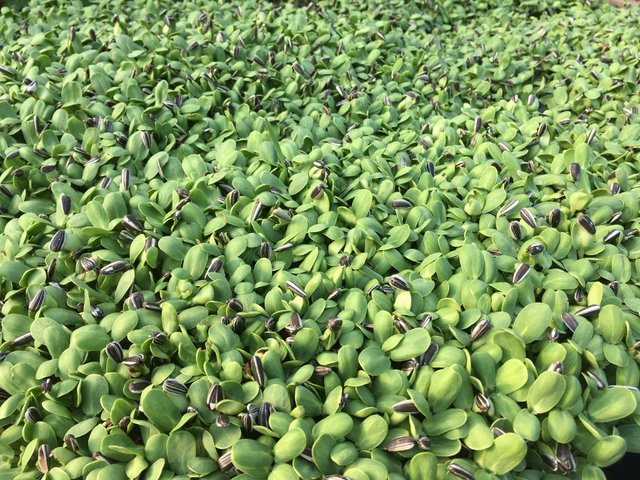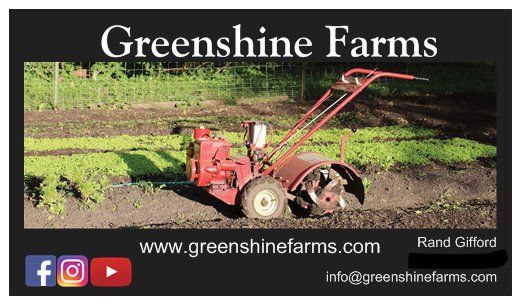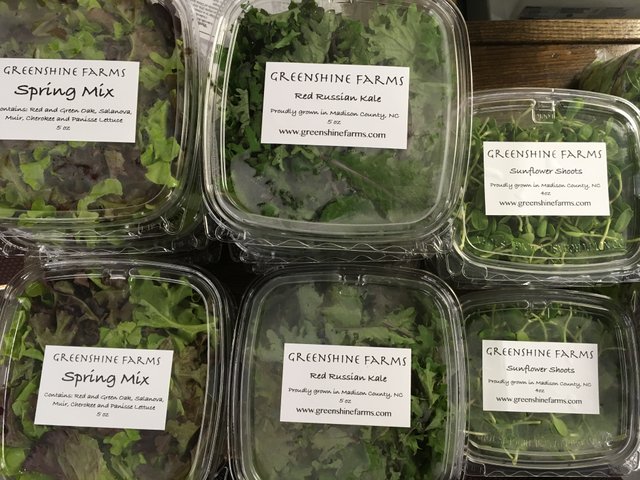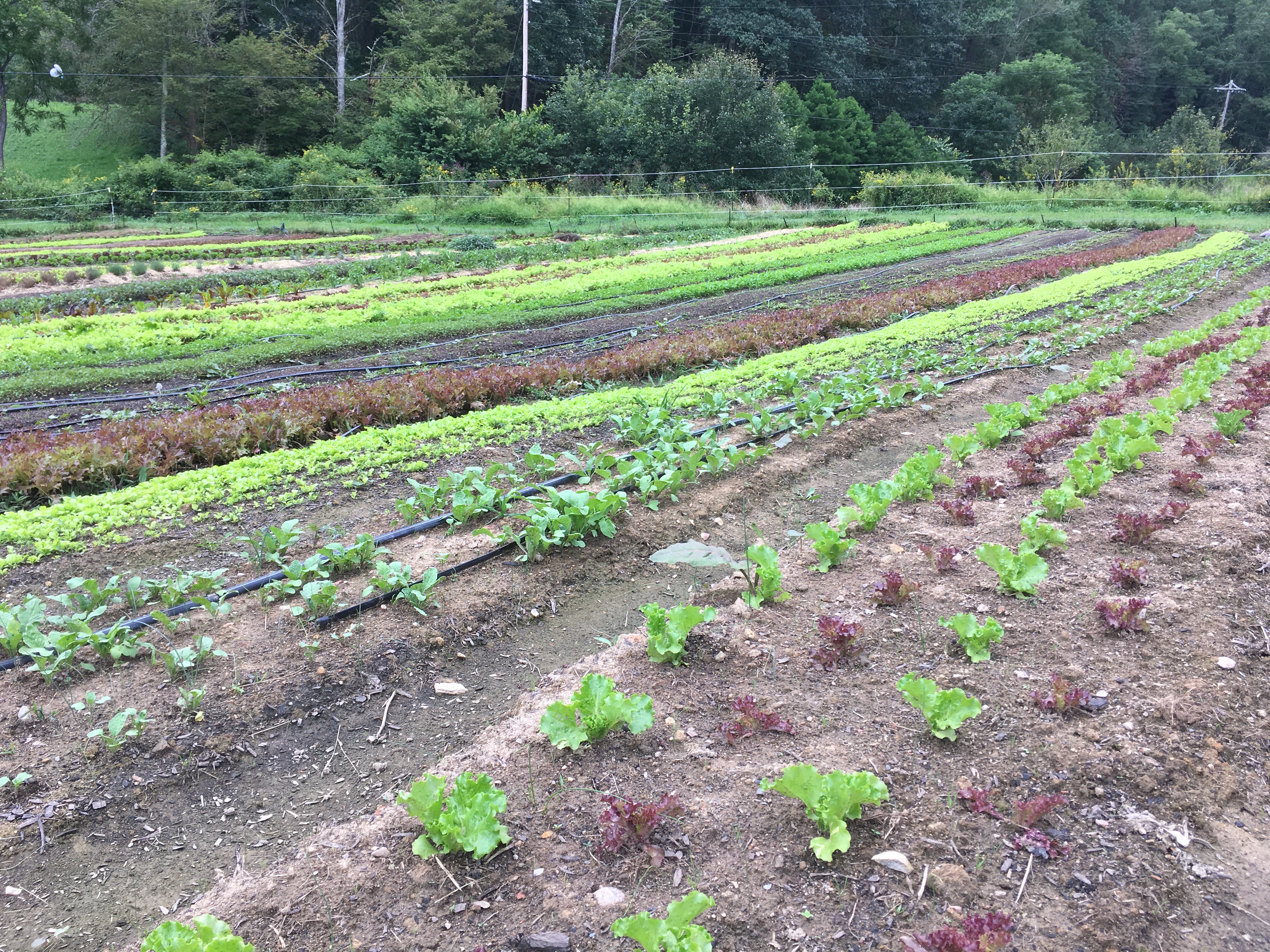How to Market and Sell Your Produce
This post is for anyone who's ever dreamed of starting a farm, or even a little side hustle to earn some extra income. However the fundamental principles laid out herein will apply equally well to any entrepreneur attempting to market and sell their product. So without further ado, let's get down to it!
Know Your Market
This is step one in any entrepreneurial venture; before you start, do your research! Make sure that the product or service you are offering is actually in demand at your given price point. If your product is not currently in demand, would it be if you offered it? For us I'll use our microgreens as an example. When I did my research on the Asheville market I figured mircogreens would be in demand based on the culinary/foodie atmosphere and the fairly health-conscious eating habits of it's consumer base.
Once you determine if there's a demand for your product the next step is to evaluate where your product is being offered and whether or not you want to outcompete the current market provider(s), or venture into an under-serviced/untapped market. As mentioned in Our Farmstead Journey Part 3: Finding a Way to Make it Pay, our current restuarant/farmer's market scene is pretty saturated. However the wholesale market, particularly grocery stores and distributors, had little to no competition. When starting out, I think it's always better to go after the low hanging fruit and build on that success before entering a more competitive space. Remember, when given the choice, take the path of least resistance.
Have a Product that Makes Sense
Before I approached any of these stores I put a lot of thought into what to sell my product for. This is kind of a dance between the grower and the buyer as you always want to get the highest possible price for your product, but at the same time the buyer needs to be able to turn a profit as well. I learned that typically grocery stores like to do a 40-60% markup on all the produce they carry. This allows them a decent margin while also accounting for potential spoilage of unsold product. I had an idea of what the average Asheville consumer was willing to pay for such an item and I also had a rough idea of what we needed to make on the backend to make it worth our while. In the end, the numbers broke down like this:
3oz of Pea Shoots sold wholesale for $3.00/each
-Suggested retail price: $3.99-$4.99
-33%-66% markup
4oz of Sunflower Shoots sold wholesale for $3.25/each
-Suggested retail price: $3.99-$4.99
-23%-53% markup

Since this was an original product that no one else was offering them I was able to get away with a little lower markup than they might've otherwise preferred. For our salad mix however, I knew I'd have to be more competitive, especially since my goal was to outcompete the mass-produced California product. I learned the stores were buying 5oz varieties of salad mix for anywhere between $2.20-$2.75/container. Since our product is 2-3 times fresher than said competition, we decided to go in at $2.75 with a suggested retail price matching that of our west coast competitors. After packaging cost, this put us at $7.80/lb. This is a decent return, however when arriving at a price point we must take into account our total cost of production, which brings me to our next part:
Know Your Numbers
It is absolutely essential to know what you need to make on a given product before selling it. If you're losing money on each transaction the only thing selling more product will do is put you out of business faster. It's also important to take into consideration crop loss and product that goes unsold. Personally I don't calculate all of my inputs down to the penny, but I have a decent idea of my overhead and what each crop costs me to produce.
Pea Shoots
Cost to Produce per tray
Seed: 10 oz=$1.25
Soil: 72oz=$0.60
Packaging + label: $0.25/each
Labor: ~15 minutes per tray @$10/hr= $2.50
Total: $4.35/per tray + packaging
Sunflower Shoots
Seed: 4oz=$1.00
Soil: 72oz=$0.60
Packaging + label: $0.25/each
Labor: ~30 minutes per tray @$10/hr= $5.00
Total: $6.35/per tray + packaging
Salad Mix
Seed: $15.00 (average)/per 100 ft bed
Fertilizer: $10.00/per 100ft bed
Compost: $25.00/per 100 ft bed
Packaging + label: $.33/per container, $1.00 per lb
Labor: ~30 minutes to harvest, 30 minutes to wash and sort (two people), 60 minutes to pack (two people): 3.5 labor hours total @ $10/hr= $35.00
Total: $85.00 + packaging
--Also consider that delivery takes me around 5 hours and uses roughly a 1/4 tank of gas.
Now that we know our cost of production, let's look at how much we're producing.
Pea Shoots
Yield: 16-18oz, 6 clamshells per tray @ 3.00/each= $18.00 gross
Net: $18.00 - $5.85 (cost of production + 6 containers @ .25/each)= $12.15/per tray
Sunflower Shoots
Yield: 16oz, 4 clamshells per tray @3.25= $13.00 gross
Net: $13.00-$7.35 (cost of production + 4 containers @.25/each)= $5.65/per tray
Salad Mix
Yield: 50 lbs, 160 containers @ 2.75/each= $440 per bed
Net: $440- $135 (cost of production + price of 160 containers @ .33/each)=$305 per bed
The numbers I give here are rough approximations. Yields vary with season and crop, but this gives a rough overview of where our numbers sit.
Make a Good Impression
This is probably the most important thing in sales. First impressions are everything and people buy from people they like. Going in with business cards, fresh samples, and a price sheet will go a long way towards making a good first impression. You not only want to show that you have a great product, but that you're someone who can be depended on when it comes to doing business. Furthermore, make sure you go in with a full-head of steam. Be energetic when you give your pitch; after all, if you can't get excited about your product, how can you expect anyone else to?

Before I got into farming I tried my hand at a variety of occupations, one of which had me selling 'integrated office solutions.' To this day I still don't know what that means and thus it isn't very surprising I wasn't any good at it. In fact I just thought I was bad at sales in general. Just the idea of it left me feeling slimy, as though I was trying to 'trick' somebody into buying from me. I later learned I was taking the wrong approach.
First, know your product. When I approach anybody interested in my produce I can list off a string of attributes that I know will resonate with them. These revolve around shelf life, flavor, nutrients, organic growing methods, and the assurance that I stand behind my product 100%. I could also mention that we have commercial liability insurance and that I can deliver high-quality produce on a consistent basis. This is great and all, but I think the biggest selling point is my enthusiasm. Farming is what I love, it's what I'm passionate about and they can see that in my eyes.
Secondly, learn what your product can do for your customer. Sales isn't about 'tricking' someone, it's about offering value and trying to see if your product is a good fit for them. Try and get into their head an ask yourself, "Why should I buy this? What does this product offer me? Could I not find a similar product elsewhere for less? Why should I give my business to this person?" By gaining an alternate viewpoint you'll be better equipped to fine tune your sales strategy and increase your chances going forward. Also, be willing to accept that not every person is a good fit for what you're offering. That's ok. Focus on bringing the customers that are a good fit the greatest value for their money.
Knowing your product exposes your customer to a given set of beliefs, namely, that you have a great product. This is where the marketing component comes in. However, knowing your customer allows you to see where your product fits within their context and what it can do for them. This is where the sales component comes in. Each potential client will have a slightly different context and being able to tailor your pitch to meeting their needs will give you the best possible chance of success.
Offer Multiple Products
Microgreens were a good gateway for us, but most of these stores only take around $30-$60 worth per week; definitely not enough to sustain our farm. The best way to increase revenue without taking on more clients is to offer your existing client base multiple products. This has a couple advantages. First off, the relationship is already established. There is a certain amount of trust that's been developed and it's easier to build off of this than to put the time into developing a new one from scratch. Secondly, it increases your resilience to potential crop failures, as well as changing market conditions.
This year I sold tomatoes, squash, zucchini, cucumbers, and radishes, in addition to our salad mix and microgreens. When I had a slow down in salad production for a week here and there I was able to supplement the lost income with some of these other products. And since we figured we could always eat/can what we didn't' sell, I priced these vegetables at a premium. Surprisingly all of our stores ended up adding at least one of these items to their orders. They were willing to pay a little bit more because they had confidence in our relationship and the products we deliver.
We also were able to provide variety within an existing product line by offering Baby Red Russian Kale, Spring Mix, and our signature Greenshine Mix. These are essentially all salad mix, but having different varieties encourages our buyers to place larger orders and gives us more shelf space in the store. This helps with brand recognition and the more people see your products, the more comfortable they'll feel purchasing it.

Focus on your Moneymakers
Even though we like to offer a good variety of crops, it's important that we focus on the crops that are most profitable. Sunflower shoots, for example, are not really that profitable, at least not for us at our current price. However we continue to offer them because they're quick-growing, consistently in demand, and it helps get our name out there. At the end of the day they are a profitable crop, just not as profitable as something like salad mix.
This is perhaps one of the greatest reasons start-up farms struggle. As farmers, we're passionate about growing food. We get that seed catalog in winter and start circling all the different varieties we plan to grow, yet once we get into the thick of it there's only so many hours to the day and oftentimes we have a tendency to spread ourselves too thin. I enjoy things like potatoes, okra, and sweet corn as much as the next guy, but from a economic perspective, these crops just don't make sense for us to grow in our current context. They require too much space, time, and equipment to do on any type of a scale, and at the end of the day, they just don't sell for very much. We might do a little planting of these in the family garden, but when it comes to growing crops for market we focus on the ones that give us the greatest return.
These crops tend to be things like salad mix, microgreens, tomatoes (particularly heirlooms and cherries), herbs, cut-flowers, mushrooms, etc. If we were to get into a farmer's market next year I would also offer things like carrots, beets, radish, and chard, which are not as profitable from a wholesale perspective, but are always in demand and fetch a decent price when it comes to direct sales. Crops such as potatoes, corn, and okra unfortunately don't make sense for us to do on any type of scale and so we'll reserve those for the family plot.

Conclusion
Again whether your goal is to make a living as a full-time farmer or just to make a little bit of cash on the side, these principles should make up the framework of any successful sales and marketing campaign. There is of course a lot more we could go into, but I hope this gives you something to build upon going forward in your entrepreneurial venture. Remember, don't be afraid to stand behind your product. This is no time for humbleness; let them know why your produce is superior to anything else on the market. Furthermore, do your best to actually ensure your produce is better than anything else on the market. As a farmer, your produce is your business card. If you consistently deliver a high-quality product eventually your customers will do your evangelizing for you.
Furthermore, don't be afraid of money. In this space more than any other there seems to be a guilt complex when it comes to turning a profit. This is a ridiculous concept and needs to be done away with. I'm not saying be greedy, but don't be afraid to price your product at a premium. After all, if it's a premium product you deserve a premium price to compensate your efforts. Profit doesn't have to be evil; profit is what allows us to continue farming so we can deliver high-quality, nutritious food to those in our community. As farmers, we're never going to make Wall Street money, but with a well thought out sales and marketing strategy we can make a good living doing what we love.
Thanks for the informative and detailed guide, this will be useful for my planning next year. Your microgreens look amazing!
Thank you. Hope it helps going forward. So much can be gained with strategic planning.
Good stuff, this is exactly what most farmer's don't understand! Sales, money, marketing...it can feel icky until you really break it down and get real with it.
I agree - in most locales, micros aren't going to sustain a farm, but they're a fantastic introductory product to get a customer used to your:
So you can then get in with the rest of your produce.
Fantastic @greenshiner. I'll be adding you to my SteemVoter once my SDB comes in!
Wow thank you!
This is the kind of quality post I'm looking for (Seems like the ratio is 20:1).
I guess I'm one of those people who struggle to see the ROI in farming endeavors. This has gotten me closer to advocating it to contacts who still haven't found their calling.
:) Keep it up.
The ROI in terms of economics is a slim game indeed. However, other things such as quality of life, time with family, eating fresh delicious food, etc. are harder to quantify but are part of the equation no less.
Stigmatatata from Lake Titicaca!
This post recieved an upvote from OPENBULL. If you would like to recieve upvotes from OPENBULL on all your posts, simply FOLLOW @openbull Please consider up-voting this comment as this project is supported only by your up-votes!

Excellent write-up with many crucial points to help people be successful. There are tons and tons of how-to-marketing books out there, and they all touch on all of these points. Educating yourself about your market is the basis for everything else. And you can't beat freindly, genuine passion for a quality product.
The only thing I would add, is to stay current with your education and knowledge of your market. There will be new competitors coming in, and old competitors going out and all kinds of changes over time. People's taste can change pretty quickly. I've sold hotel rooms and air filters, without much passion, I'm hoping having good natural products will be easier.
When I first started exploring this type of smaller scale farming, I dreamed what it would be like to have access to a market like Chicago. The land prices and property taxes were just too much for me, but it sure would be fun to try for anyone with that opportunity.
Good point. Always Be Evolving. A big market definitely has it's advantages, but with that bigger market comes bigger competition. If you think about it, you could make a really good living growing food for 100 families. 100 CSA shares at $650 each would gross $65,000. These numbers could be scaled up or down, but the possibility exists to earn a decent living by finding a select number of people that really love and support what you do.
Congratulations @greenshiner! You have completed some achievement on Steemit and have been rewarded with new badge(s) :
Click on any badge to view your own Board of Honor on SteemitBoard.
For more information about SteemitBoard, click here
If you no longer want to receive notifications, reply to this comment with the word
STOPThe information will go a long way in assisting me in my farming venture
Glad to hear that! Reach out if you need any advice along the way. Best of luck in your pursuits!
Congratulations on finding your niche! You have made a lot of valid points and given us a much better idea what marketing your crop is all about. Your crops look amazing and that is why they sell.
Thank you, I definitely appreciate that. We try hard to produce a quality product.
I have an organic garden plot that has been latent almost a year due to my recovery from a pit bull attack. The local demand for nutritionally-dense bio-dynamic food-stuffs is sometimes not what the buyers thought they wanted due to not knowing that it is available.
I previously managed an operation which sold almost exclusively to restaurants. Hot peppers were a big item. However, organic habaneros was king; topping even specialty mushrooms.
Very interesting. We might have to go big into the habeneros next year. Hope your recover is going well and that you can get that garden plot up and running again next year. Let me know if I can lend any advice.
Wow! Fantastic post!
I am pleased to announce that your post has been featured in Max Curation Edition No. 16 published on Steemit.
You can take a look at it HERE.
Please resteem the Max Curation Edition so that all your followers also feel proud of you, and make it a point to visit your upcoming posts. Resteeming my post will also grant the curation effort more visibility. Thanks!
Don't forget to follow me so that you can receive the Curated Editions in your feed.
Congratulations and Steem On!